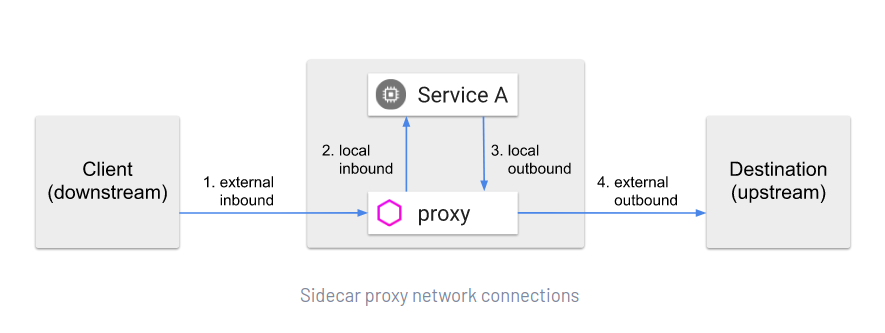https://istio.io/latest/docs/ops/configuration/traffic-management/tls-configuration/
Sidecars
Sidecar traffic has a variety of associated connections. Let’s break them down one at a time.

Sidecar proxy network connections
- External inbound traffic This is traffic coming from an outside client that is captured by the sidecar. If the client is inside the mesh, this traffic may be encrypted with Istio mutual TLS. By default, the sidecar will be configured to accept both mTLS and non-mTLS traffic, known as
PERMISSIVEmode. The mode can alternatively be configured toSTRICT, where traffic must be mTLS, orDISABLE, where traffic must be plaintext. The mTLS mode is configured using aPeerAuthenticationresource. - Local inbound traffic This is traffic going to your application service, from the sidecar. This traffic will always be forwarded as-is. Note that this does not mean it’s always plaintext; the sidecar may pass a TLS connection through. It just means that a new TLS connection will never be originated from the sidecar.
- Local outbound traffic This is outgoing traffic from your application service that is intercepted by the sidecar. Your application may be sending plaintext or TLS traffic. If automatic protocol selection is enabled, Istio will automatically detect the protocol. Otherwise you should use the port name in the destination service to manually specify the protocol.
- External outbound traffic This is traffic leaving the sidecar to some external destination. Traffic can be forwarded as is, or a TLS connection can be initiated (mTLS or standard TLS). This is controlled using the TLS mode setting in the
trafficPolicyof aDestinationRuleresource. A mode setting ofDISABLEwill send plaintext, whileSIMPLE,MUTUAL, andISTIO_MUTUALwill originate a TLS connection.
The key takeaways are:
PeerAuthenticationis used to configure what type of mTLS traffic the sidecar will accept.DestinationRuleis used to configure what type of TLS traffic the sidecar will send.- Port names, or automatic protocol selection, determines which protocol the sidecar will parse traffic as.
Auto mTLS
As described above, a DestinationRule controls whether outgoing traffic uses mTLS or not. However, configuring this for every workload can be tedious. Typically, you want Istio to always use mTLS wherever possible, and only send plaintext to workloads that are not part of the mesh (i.e., ones without sidecars).
Istio makes this easy with a feature called “Auto mTLS”. Auto mTLS works by doing exactly that. If TLS settings are not explicitly configured in a DestinationRule, the sidecar will automatically determine if Istio mutual TLS should be sent. This means that without any configuration, all inter-mesh traffic will be mTLS encrypted.
FAQ
- What is the difference between MUTUAL and ISTIO_MUTUAL TLS modes?
Both of these DestinationRule settings will send mutual TLS traffic. With ISTIO_MUTUAL, Istio certificates will automatically be used. For MUTUAL, the key, certificate, and trusted CA must be configured. This allows initiating mutual TLS with non-Istio applications.
- What is TLS Origination?
TLS origination occurs when an Istio proxy (sidecar or egress gateway) is configured to accept unencrypted internal HTTP connections, encrypt the requests, and then forward them to HTTPS servers that are secured using simple or mutual TLS. This is the opposite of TLS termination where an ingress proxy accepts incoming TLS connections, decrypts the TLS, and passes unencrypted requests on to internal mesh services.